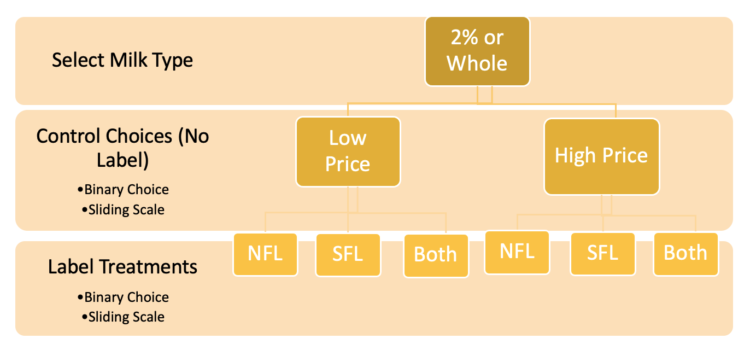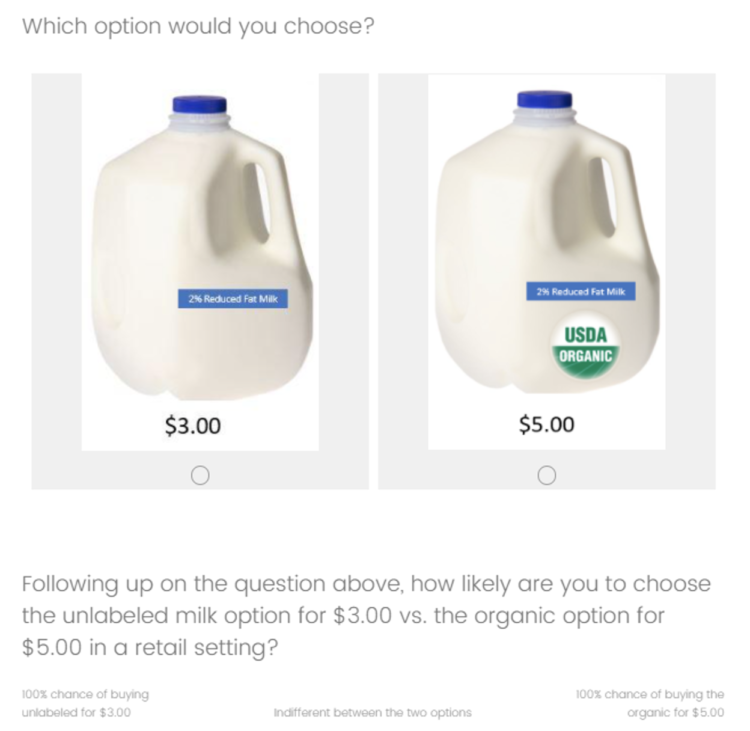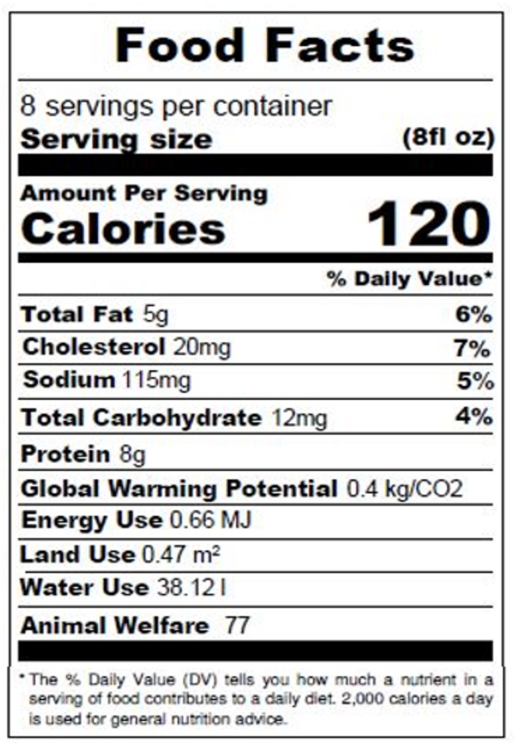Can a sustainability facts label reduce the halo surrounding organic labels (Neuhofer et al., 2023)?
May 10, 2023
PAER-2023-20
Zachary T. Neuhofer, agricultural economics doctoral student
Motivation
A common method used to relay information about food products are labels such as, the Nutrition Facts Label (NFL) and the USDA organic label. Consumers often use food labels to form beliefs about food attributes they are uncertain of. In some cases, these beliefs may be unsupported by the best scientific evidence. One common label that consumers often form unsupported beliefs about is the USDA organic label. Prior research has found that many consumers believe that products with a USDA organic label are healthier or better for the environment than their conventional alternatives (Campbell et al., 2014; Chandon, 2013; Durham, 2007; Schleenbecker & Hamm, 2013).
Currently, there are no environmental labels on food products that provide objective scientific information that resemble a layout like the NFL. Some environmental and sustainability labels are a signal that specific certifications have been met such as, the USDA organic label, Energy Star certification, or Safer Choice labels (EPA, 2020; USDA, 2022). Other labels such as, the EnergyGuide labels on appliances provide quantitative scientific data, but are limited to a single metric (Newell & Siikammki, 2014). This leads us to consider if a standardized “sustainability facts label” (SFL) could decrease consumers’ unsubstantiated health and environmental beliefs about organic products.
Methods
We undertake a survey of consumers to better understand how information provided in a label affects the choice of organic, as well as beliefs related to the healthiness, taste, environmental impact, and animal welfare of organic and non-organic options.
We collected our data through an online survey using a nationally representative sample of 2000 milk consumers in the US (Figure 1). To qualify for our survey, the respondent had to state they purchased dairy milk at least once every few months and be a primary shopper in their household. Respondents began the experiment by selecting whether they preferred 2% or whole milk. Next, they answered questions regarding their beliefs on a variety of health and environmental metrics comparing organic and conventional milk. The next portion was the initial control choice in which the consumers chose between an organic and conventional option both in a binary choice and a sliding scale indicating the intensity of preference, and were separated into two price treatments (Figure 2). After the control choice, the respondents were exposed to one of three label treatments; the NFL only, the SFL only, or both the NFL and SFL. After the choices, the respondents answered the belief questions again as a manipulation check and demographic information.
The label design included information gathered from nutrition and environmental data on milk production. We collected the nutrition data from the USDA ARS database for both conventional and organic milk (USDA ARS, 2022). The data collected for the environmental facts were gathered from life cycle analyses (LCAs) on organic and conventional milk production in the United States, and European Union (EU) countries such as, the Netherlands, and Germany from 2001-2020 (J. L. Capper et al., 2009; Judith L. Capper & Cady, 2020; de Vries & de Boer, 2010; Thomassen et al., 2008). International estimates were included for two primary reasons; one is that there was a general lack of LCAs conducted on US farms for organic milk, another is that organic certifications in the EU are generally accepted and labeled as USDA organic when sold in the US (USDA AMS, 2016, 2022). The metrics we included were the calories, total fat, cholesterol, sodium, total carbohydrates, protein, global warming potential, energy use, land use, water use, and an animal welfare measurement (Figure 3).
We estimated our results primarily using a statistical model known as a logistic regression. We assume the choice of organic is dependent on the price difference between organic and conventional milk, and the label treatments the respondents were placed in. Additionally, we use t-tests and chi-squared tests to make statistical comparisons between groups.
Results
We observed that respondents in the low price organic treatment were more likely to select organic than those in the high price treatment from a chi-squared test. Additionally, we observed that a significant number of participants changed their choice from either conventional to organic or vice versa after exposure to the labels. When controlling for all treatment effects in the regression model and individual specific effects, we find that those exposed to either the SFL alone or both labels were more likely to select organic milk.
We did find that the facts panels altered the beliefs of the respondents. Those exposed to the SFL increased their perception that organic performed better on environmental metrics than conventional. Those exposed to the NFL decreased their perception that organic had fewer calories and more protein than conventional.
Conclusions
We observe that the presence of the SFL increases the likelihood of choosing organic which is contrary to our hypothesis. We had predicted that information that showed similarity in the environmental impact between organic and conventional milk would decrease the likelihood of selection or at least be insignificant at altering the beliefs or choice. It may be that consumers did not understand the metrics on the label using the scientific units seen in LCAs and would be understood better using either environmental messages or unit approximations such as “carbon emissions per mile traveled by a car”. The results of this study show that using labels presenting objective scientific data may not be the best way to display sustainability information. In an era where consumers increasingly care about animal welfare and sustainability of food products, other label options may need to be considered to effectively communicate this information.
References
Campbell, B. L., Khachatryan, H., Behe, B. K., Dennis, J., & Hall, C. (2014). U.S. and Canadian Consumer Perception of Local and Organic Terminology. International Food and Agribusiness Management Review, 17(21–40).
Capper, J. L., Cady, R. A., & Bauman, D. E. (2009). The environmental impact of dairy production: 1944 compared with 2007. Journal of Animal Science, 87(6), 2160–2167. https://doi.org/10.2527/jas.2009-1781
Capper, Judith L., & Cady, R. A. (2020). The effects of improved performance in the U.S. dairy cattle industry on environmental impacts between 2007 and 2017. Journal of Animal Science, 98(1), 1–14. https://doi.org/10.1093/jas/skz291
Chandon, P. (2013). How package design and packaged-based marketing claims lead to overeating. Applied Economic Perspectives and Policy, 35(1), 7–31. https://doi.org/10.1093/aepp/pps028
de Vries, M., & de Boer, I. J. M. (2010). Comparing environmental impacts for livestock products: A review of life cycle assessments. Livestock Science, 128(1–3), 1–11. https://doi.org/10.1016/j.livsci.2009.11.007
Durham, C. A. (2007). The impact of environmental and health motivations on the organic share of produce purchases. Agricultural and Resource Economics Review, 36(2), 304–320. https://doi.org/10.1017/S1068280500007115
EPA. (2020). Recommendations of Specifications, Standards, and Ecolabels for Federal Purchasing | Sustainable Marketplace: Greener Products and Services | US EPA. https://www.epa.gov/greenerproducts/recommendations-specifications-standards-and-ecolabels-federal-purchasing
Neuhofer, Z. T., Lusk, J. L., & Villas‐Boas, S. (2023). Can a sustainability facts label reduce the halo surrounding organic labels? Applied Economic Perspectives and Policy, November 2022, 1–31. https://doi.org/10.1002/aepp.13350
Newell, R. G., & Siikammki, J. (2014). Nudging Energy Efficiency Behavior: Role of Information Labels. SSRN Electronic Journal, 1(4). https://doi.org/10.2139/ssrn.2467676
Schleenbecker, R., & Hamm, U. (2013). Consumers’ perception of organic product characteristics. A review. Appetite, 71, 420–429. https://doi.org/10.1016/j.appet.2013.08.020
Thomassen, M. A., van Calker, K. J., Smits, M. C. J., Iepema, G. L., & de Boer, I. J. M. (2008). Life cycle assessment of conventional and organic milk production in the Netherlands. Agricultural Systems, 96(1–3), 95–107. https://doi.org/10.1016/j.agsy.2007.06.001
USDA. (2022). Guidelines for Organic Certification of Dairy Livestock. https://www.ams.usda.gov/sites/default/files/media/Dairy – Guidelines.pdf
USDA AMS. (2016). Importing Organic Products in to the US. https://www.ams.usda.gov/sites/default/files/media/Importing Organic Products Factsheet.pdf
USDA AMS. (2022). AMS Dairy Program – EU Dairy and Composite Product Certification Programs. https://www.ams.usda.gov/services/imports-exports/dairy-exports/eu-dairy-exports
USDA ARS. (2022). FoodData Central. https://fdc.nal.usda.gov/index.html

Figure 1: Experimental Flow

Figure 2: Control Choice Example with Sliding Scale

Figure 3: Example of Both Labels Combined: Organic, 2% milk
